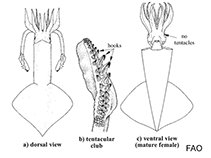Onykia robusta (Verrill, 1876)
Robust clubhook squid| Native range | All suitable habitat | Point map | Year 2050 |

|
| This map was computer-generated and has not yet been reviewed. |
| Onykia robusta AquaMaps Data sources: GBIF OBIS |
Upload your photos
Google image | No image available for this species;
drawing shows typical species in Onychoteuthidae.
Google image | No image available for this species;
drawing shows typical species in Onychoteuthidae.
Classification / Names Tên thường gặp | Các synonym ( Các tên trùng) | CoL | ITIS | WoRMS
Cephalopoda | Oegopsida | Onychoteuthidae
Environment: milieu / climate zone / Mức độ sâu / distribution range Sinh thái học
Tầng nổi; Mức độ sâu 32 - 528 m (Tài liệu tham khảo 101455). Subtropical; 61°N - 36°N, 145°E - 126°W (Tài liệu tham khảo 275)
Distribution Các nước | Các khu vực của FAO | Các hệ sinh thái | Những lần xuất hiện | Những chỉ dẫn
Northern Pacific and the Arctic. Subtropical to polar.
Length at first maturity / Bộ gần gũi / Weight / Age
Chín muồi sinh dục: Lm ? range ? - ? cm Max length : 200 cm ML con đực/không giới tính; (Tài liệu tham khảo 275); common length : 160 cm ML con đực/không giới tính; (Tài liệu tham khảo 97142); Khối lượng cực đại được công bố: 50.0 kg (Tài liệu tham khảo 275)
Maximum mantle length of 200 cm (Ref. 275), 230 cm may be an error (Ref. 97142). Occurs near the seafloor and in pelagic waters (Ref. 102863). Reported to feed on benthic fish, echinoderms and a pleustonic jellyfish (Ref. 98552). Predators include sperm whales, shark and fur seals (Ref. 102863).
Life cycle and mating behavior Chín muồi sinh dục | Sự tái sinh sản | Đẻ trứng | Eggs | Sự sinh sản | Larvae
Members of the class Cephalopoda are gonochoric. Male and female adults usually die shortly after spawning and brooding, respectively. Mating behavior: Males perform various displays to attract potential females for copulation. During copulation, male grasp the female and inserts the hectocotylus into the female's mantle cavity where fertilization usually occurs. Life cycle: Embryos hatch into planktonic stage and live for some time before they grow larger and take up a benthic existence as adults.
Main reference
Các tài liệu tham khảo | Người điều phối | Người cộng tác
MarineSpecies.org. 2050. (Tài liệu tham khảo 3477)
IUCN Red List Status
(Tài liệu tham khảo 130435: Version 2024-2)
Data deficient (DD) ; Date assessed: 10 May 2010
CITES status (Tài liệu tham khảo 108899)
Not Evaluated
CMS (Tài liệu tham khảo 116361)
Not Evaluated
Threat to humans
Human uses
Các nghề cá: có khả năng có lợi
| FishSource |
Các công cụ
Thêm thông tin
Sinh thái dinh dưỡng
Sinh thái học
Population dynamics
Sự sinh trưởng
Max. ages / sizes
Length-weight rel.
Length-length rel.
Length-frequencies
Mass conversion
Bổ xung
Sự phong phú
Max. ages / sizes
Length-weight rel.
Length-length rel.
Length-frequencies
Mass conversion
Bổ xung
Sự phong phú
Life cycle
Distribution
Human Related
Aquaculture profiles
Stamps, coins, misc.
Stamps, coins, misc.
Outreach
Taxonomy
Các tài liệu tham khảo
Các nguồn internet
BHL | BOLD Systems | CISTI | DiscoverLife | FAO(Publication : search) | Fishipedia | GenBank (genome, nucleotide) | GloBI | Gomexsi | Google Books | Google Scholar | Google | PubMed | Cây Đời sống | Wikipedia (Go, tìm) | Tạp chí Zoological Record



